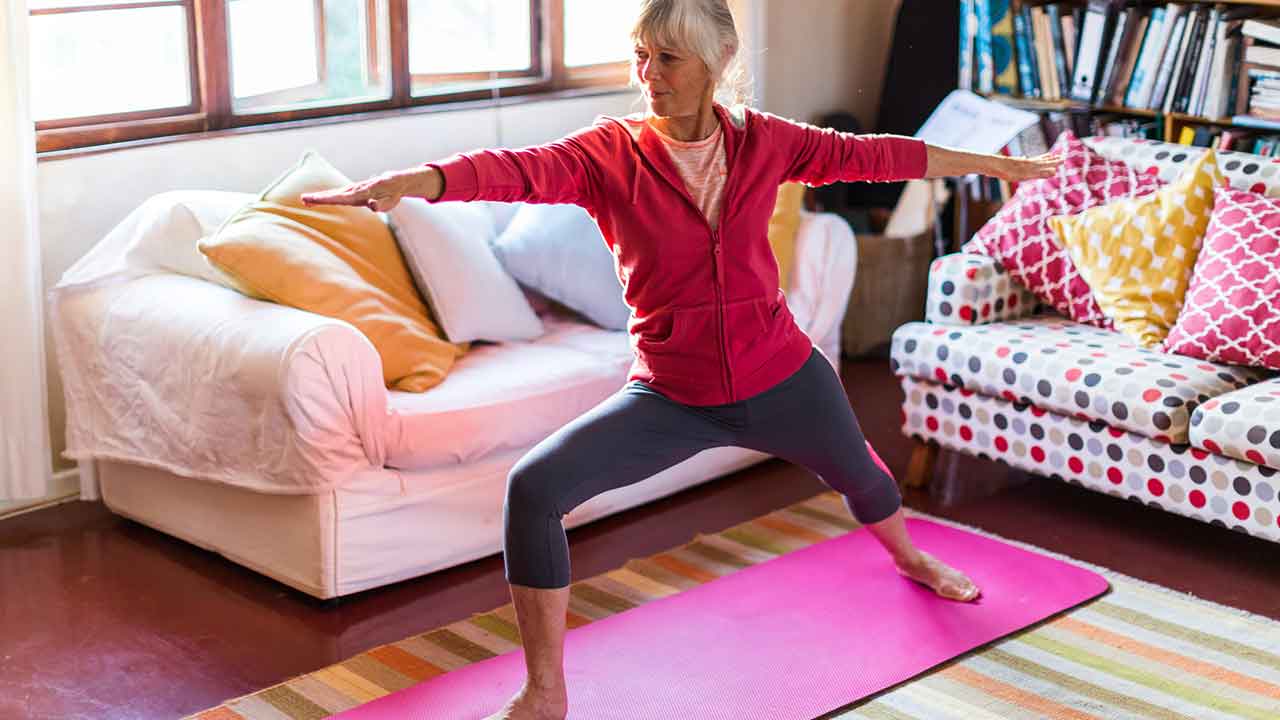12 best yoga poses to strengthen bones

A rehabilitation doctor and yogi of 50 years says your yoga practise is doing way more than centring your mind and opening your joints.
If you’re like many yoga lovers, you appreciate how this one physical activity can be so beneficial, while simultaneously so gentle. Few other practises stretch your body, calm your mind or help regulate vitals, such as your heart rate and blood pressure, in quite the way a regular yoga session can do.
Researcher and rehabilitation doctor, Dr Loren Fishman has also been a practitioner of yoga for 50 years and is the creator of ‘the Fishman method’ of yoga for osteoporosis. In a conversation with Reader’s Digest, Dr Fishman points out that for all its advantages, yoga can also provide a powerful boost to your long-term bone density. In particular, Dr Fishman published 12 yoga poses in Orthopedic Nursing that are particularly great for strengthening your bones.
Of these 12 poses Dr Fishman says: “They all work by putting pressure on the bones of sufficient magnitude and duration.” He says this can “stimulate the osteoblasts to make more bone”, thanks to their placement of “maximum torque, compression or pressure” on particular body parts, as outlined below.
So, while a good yoga session is a helpful tool to help you get through the week, its effects are longer-lasting than you realised.
Keep reading for the 12 best yoga poses to strengthen your bones. (“With all poses, remember not to round the spine as you go into and out of the poses, and within the poses themselves,” Dr Fishman advises.)
Whether you’re a yoga beginner or expert, it’s important you have the right mat. Check out these mats from Gaiam.
1. Tree pose (Vriksasana)

Tree pose has a special way of calling you to stillness. Dr Fishman says tree pose also adds pressure that can strengthen the upper femur and hip. He adds that a study at the University of Southern California (USC) showed a 60 per cent increase in pressure, even with the foot placed three-quarters down the calf.
Dr Fishman says tree pose is “also extremely valuable for improving balance and avoiding falls,” although he reminds us that the raised foot should always go above or below the knee – never directly on the knee joint.
2. Triangle pose (Trikonasana)
Triangle pose “puts torque on the lumbar spine, the neck of the femur, the hips and ribs,” Dr Fishman says, adding that this is another pose that will help improve balance.
Look and feel the part in these comfortable yoga clothes from Gaiam.
3. Reverse Triangle Pose (Parivrtta Trikonasan)
Dr Fishman says great pressures develop on the proximal femurs (very top of the femur bone that connects with the hip joint) in this pose, as well as the hip and lower back. Reverse triangle also puts helpful pressure in the ribs and wrists and is “a very powerful balance-improver.”
4. Warrior 2 (Virabhadrasana II)
“Fabulous mechanical disadvantage means great pressure on the entire forward (bent leg) femur,” Dr Fishman says of full warrior pose. He explains that “the straight leg’s rotation works on the head of femur and hip,” helping to strengthen the upper leg and hip. This is yet another pose that he says helps with balance.
5. Side angle pose (Parsvakonasana)
Another boon for balance, Dr Fishman says side angle pose torques the lower back and the top of the femur – all good things – and stimulates the bone-making cells of the hip, too.
Keep your workout going with this no-knots massage ball from Gaiam – perfect for releasing tension and relieving stiffness.
6. Locust pose (Salabhasana)
Locust pose “raises pressures, which stimulate bone-making in the posterior elements of the spine,” Dr Fishman says, while it also helps balance some the forward focus on the ribs of the earlier poses. Locust pose also strengthens extensor muscles of the back to improve posture and reverse curvature of the spine in the upper back, which can lead to fractures.
7. Bridge pose (Setu Bandhasana)
Dr Fishman says bridge pose can help strengthen the ribs and lower regions of the spine.
8. Reclining hand to big toe (Supta Padangusthasana I)
Also known to be a good hamstring stretch, this pose facilitates “extreme pressure brought to bear on relevant sections” of the femur, hip, pelvis (specifically the sitz bones) and spine.
Seated versions of this and the following pose offer less intensity, but Dr Fishman cautions for both: “The seated versions have the potential to be dangerous. Keep the spine straight and against the back of the chair. Do not round the back.”
9. Supine hand to big toe 2 (Supta Padangusthasana II)
In the side extension variation of this pose, there is “extreme pressure brought to bear” on the upper femur, hip, pubis, ribs, and spine, he says.
10. Straight-legged twist (Marichyasana)
This “puts great pressure” on the sitz bones and pelvis, as well as “great but safe pressure” on the spine.
11. Bent-leg twist (Matsyendrasana)
The bent-leg twist “puts great pressure” on the upper femur and pelvis, plus “great but safe pressure” on the vertebra. Dr Fishman suggests you should hug the leg to ensure a straight spine.
Staying hydrated during your yoga session is vital to maintain muscle health. Check out these insulated stainless-steel water bottles designed for every kind of workout.
12. Corpse pose (Savasana)
Truthfully, Dr Fishman says, Savasana is “of little value for the bones per se, but truly important at the end of the session for mental and general physiological health.” That’s good enough for us.
Written by Jennifer Huizen and Kristine Gasbarre. This article first appeared in Reader’s Digest.
Image: Getty Images
